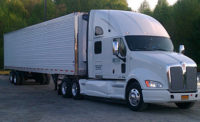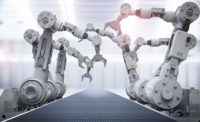Over the last 20 years, the industrial market has been the primary adopter of robotics technology, and has accounted for the majority of all robot spend. Largely due to the size and power of most industrial robots in use today, these systems are typically installed in caged environments with minimal human contact for various safety reasons.
However, due to advancements in computer vision and motion sensing capabilities, a new type of industrial robot has emerged, known as collaborative robots, or co-bots. While the co-bot market is small today, this sub-category will see extraordinary growth over the next 10 years, according to a report published by Loup Ventures, Minneapolis.
The industrial market is broken down into two sub-categories:
- Traditional industrial robots. Most traditional robots are installed in caged environments away from people, allowing them to handle heavy payloads and operate at fast speeds. However, the high integration costs associated with industrial robots limits the flexibility of these machines. In addition, traditional robots typically require programming from advanced software engineers.
- Collaborative industrial robots (co-bots). Co-bots are built with multiple motion and force detecting sensors, making it safer for these systems to collaborate alongside humans. Programming co-bots is also less sophisticated than traditional robots.
Industrial robot market to grow to $33.8B by 2025
According to the International Federation of Robotics (IFR), Germany, a total of 253,748 industrial robots were delivered in 2015, and the total market value grew 9.0% year over year to $11.1 billion. Of all the industrial units shipped, about 250,073 of industrial robots were in the form of traditional systems, while the remaining 3,675 units were collaborative machines.
Over the next 10 years, the traditional industrial market will see healthy growth, but due to lower costs and higher flexibility, the co-bot market will experience a much faster adoption. In fact, the total co-bot units shipped will increase from 8,950 in 2016 to 434,404 by 2025, representing a 61.2% CAGR. Over this timeframe, costs will continue to come down, and the total co-bot market value will exceed $9.0 billion by 2025.
Co-bots will drive overall industrial growth, and the traditional market will see steady adoption. The traditional market alone will represent a $24.0 billion market by 2025. In total, the industrial robotics market will grow 11.8% on an annual basis to over $33.0 billion in the next 10 years.
China, U.S. to see strongest industrial robot adoption
From a geographic perspective, Asia and China have historically been the largest buyers of industrial robot technology. According to IFR, China consumed 68,556 industrial robots in 2015, which represented 27.0% of all robots sold. Meanwhile, the Republic of Korea, North America, Japan and Germany rounded out the Top 5, respectively. Over the next 10 years, the install base of industrial robots is expected to increase in almost every single country, but China and North America will see the fastest adoption of industrial robots.
Meanwhile, annual units shipped to China and North America will grow 22.1% and 20.4%, respectively on a CAGR basis through 2025. Rising labor costs will be a lead catalyst to robot adoption in both regions, but bringing manufacturing back to the United States will be a potential driver in North America.
Automotive, electronic verticals to drive demand
From a vertical standpoint, the automotive and electronics industries have been the largest integrators of industrial robots. According to the IFR, 97,500 and 64,600 industrial robots were sold to automotive and electronic in 2015, respectively. Metal and machinery as well as the plastics and rubber industries are also large buyers of industrial robots.
Robot adoption is expected to grow in all four verticals over the next 10 years, but due to the high demand for new electronic products (e.g. smartphones, wearables, etc.), robot adoption in the electronic manufacturing space will experience above-average growth. That said, the rise of the low-cost collaborative robot movement will access automation technology to a handful of new applications, which will drive adoption across a handful of new verticals.
Bottom line
Today, the industrial robot market accounts for the highest percentage of all robot spend (61%), and by 2025, industrial will remain the largest robotics category. However, due to advancements in computer vision, artificial intelligence and motion sensing capabilities, collaborative robots are beginning to take center stage.
In the manufacturing sector, robots and humans are beginning to work together side-by-side; as a result the co-bot industrial market will likely be one of the fastest growing markets in the robotics space. That said, co-bots will remain limited to certain applications given payload and speed constraints and demand for traditional robots will remain strong. Key drivers to growth in the industrial sector will include lower costs, improved robot functionalities, rising labor costs and manufacturing insourcing.






